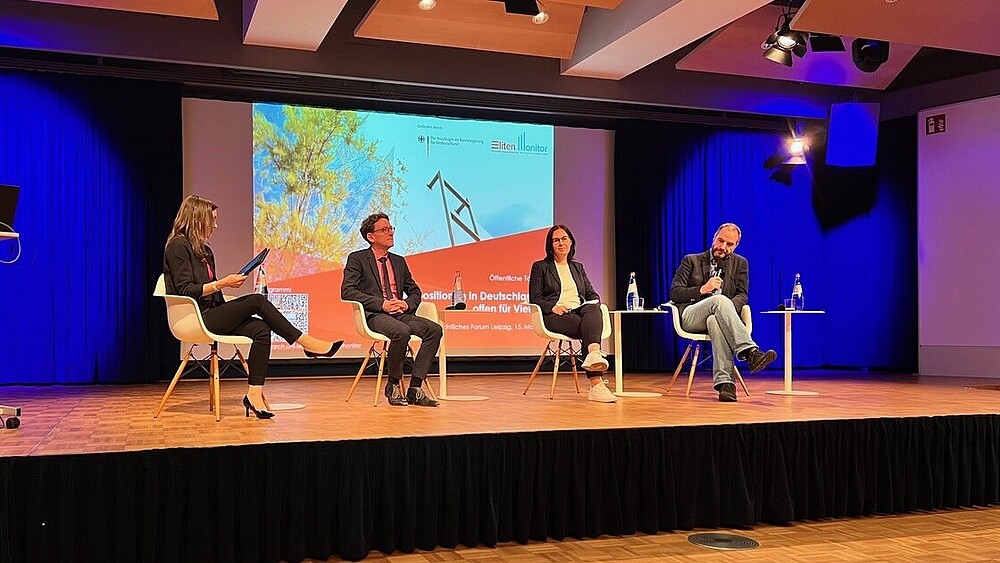Prof. Dr. Raj Kollmorgen reports on the transfer event "Top positions in Germany - open to diversity?"

On May 15, 2025, the transfer event of the joint research project Elitenmonitor , in which the TRAWOS Institute of the HSZG is involved with a sub-project (project team: Raj Kollmorgen, Jan Schaller, Mara Börjesson) and which is funded by the Federal Chancellery and the Federal Government Commissioner for Eastern Germany (2022-2025), took place at the Zeitgeschichtliches Forum Leipzig.
After a brief introduction by the project spokesperson of the joint project, Dr. Lars Vogel, the event kicked off with a welcome address by the new Federal Government Officer for Eastern Germany, Minister of State Elisabeth Kaiser. She acknowledged the importance of the project, which was initiated by her predecessor Carsten Schneider, and emphasized its relevance for the analysis of social participation and representation as well as the current challenges in German-German relations.
In the first thematic block, key findings from the research project were presented: Dr. Lars Vogel used the Leipzig elite database - a collection of biographical data from over 4.000 elite position holders - showed how the proportion of East Germans in central top positions has developed over the past 6 years and drew a mixed conclusion: slight increases in individual sectors (e.g. politics, science, media) are offset by sectors in which the numbers remain at a consistently low level or are even declining (e.g. military, business, culture).
Prof. Dr. Marion Reiser then presented the results of the elite survey, in which elite members were asked about their attitudes and self-images. While around half of West German elite members see the under-representation of East Germans in the elite as a problem for the representation and assertion of interests, this figure is over 85% among East German members. And while West German elites emphasize the importance of expert knowledge for the final step into the elite position, East German elite members see a greater relevance of willingness to make sacrifices and vertical contacts compared to West Germans.
As a degree, Prof. Dr. Raj Kollmorgen discussed the findings from qualitative interviews with East German elite members: in particular, he shed light on the obstacles to advancement and the factors that promote advancement at the various career levels. For example, there are level-specific requirements for promotion to the next career level. The overarching mechanism is the recruitment logic of being wanted and in demand, which refers centrally to the role of social capital and networks. This in turn presupposes that the aspirants are present early on in central institutions and, best of all, in positions close to management in the respective sector. However, East Germans tend to be at a disadvantage in both aspects, as the low density of institutions and companies in the East German federal states requires early mobility of East German aspirants. Reference was also made to the role of homophily - i.e. the preference for socially similar people - in the recruitment process.
The second block broadened the focus to other underrepresented groups: Women and people with a migration background. In her contribution, Prof. Dr. Miriam Hartlapp (Freie Universität Berlin) addressed the structural disadvantage of women in the Bundestag and referred, among other things, to France, where a legal parity regulation has significantly improved representation. Prof. Dr. Sabrina Zajak (DeZIM) then spoke about access barriers for people with a migration background. Particular attention was paid to the difficulty of conceptualizing this extremely heterogeneous group - a challenge that has a considerable impact on the data situation and interpretations in representation research.
In the third thematic block, Prof. Dr. Astrid Lorenz (University of Leipzig) presented specific recommendations for action to strengthen East German representation, which were developed as part of the Elitenmonitor project. In addition to the individuals themselves, these also addressed organizations and the system as a whole, with the recommendations for action focusing on the role of mentorships and networks as well as support through scholarships in order to compensate for structural disadvantages. At the same time, however, they also call on East German aspirants to take a closer look at the criteria for career development and the prerequisites for successful careers.
Following this, a panel of East German leaders, moderated by Prof. Dr. Astrid Lorenz and Linus Paeth, discussed perspectives for more diversity in the elite. Also present were:
The debate on the podium represented the entire spectrum of the discourse regarding the underrepresentation of East Germans and showed a variety of experiences, assessments of the current situation and recommendations for action from their own practice.